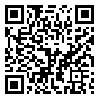Volume 8, Issue 15 (9-2018)
mth 2018, 8(15): 25-38 |
Back to browse issues page
1- BA student of textile design, University of Semnan, Iran.
2- Instructor, Faculty of Art, University of Semnan. Semnan, Iran. , samira.toosi@semnan.ac.ir
2- Instructor, Faculty of Art, University of Semnan. Semnan, Iran. , samira.toosi@semnan.ac.ir
Abstract: (5156 Views)
Religious thoughts presented through beautiful artistic forms have always had a deep effect on humans. As traditional forms of art were often used for expressing religious ideas, these ideas were diffused from one civilization to another. Artists of other civilizations used these forms to express their own religious beliefs. The present study seeks to compare and contrast the underlying ideologies of two needlework arts, namely, Iranian dervish embroidery and Japanese Sashiko. The main research questions are: 1) What was the basis of dervish embroidery on the garments of dervishes and Sashiko on kimonos? 2) What specific cultural exchanges took place between Iranian and Japanese culture? The findings suggest that the foundation of both types of needlework is geometric shapes with equal orders that are based on numbers and colors and aim at expressing deep ritual notions. Rooted in Iranian Sufism (which is no doubt based on Quran and Islamic tradition), dervish embroidery draws upon numbers, colors, prayers, and geometric shapes that all contain deeply concealed secrets. According to the theory of rippling diffusion, which refers to transfer of Iranian culture toward the east, and with reference to historical documents from the Far East, Japanese culture has incorporated many Iran' cultural influences and used a number of Iranian artistic motifs in its art. As a result, Sashiko has sometimes been interpreted with regard to ritual thoughts concerning the divine incarnation within nature as well as respect for nature and its elements. The research method is analytical-comparative. For the purpose of recognizing the motifs and colors in these two types of needlework, some pieces of clothing and their patterns will be analyzed and discussed.
Type of Study: Research |
Subject:
Visual Arts
| Rights and permissions | |
 |
This work is licensed under a Creative Commons Attribution-NonCommercial 4.0 International License. |


